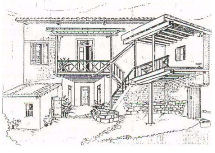 |
 |
We can stop catastrophic climate change.
We know
what causes it, we have the technologies to prevent it, and
there's a rapidly growing understanding of just how urgent
the need for action is.
So have a look at alternative energy, how you could help the planet and
help yourself.
This is not an
advertisement. its just commonsense. |
 |
Solar Hot Water Energy
Thermosyphon solar water heaters are
widely used for domestic water heating due to their
simplicity
in construction, installation and maintenance and their cost
effectiveness as compared to conventional methods of water
heating.
In
Cyprus, for example, it is estimated
that there are more than 130,000 units in operation, which
means one solar water heater for five people in the island.
According to Construction and Housing Statistics for 1987 [1
], about 87% of new dwellings built in 1987 have been
equipped with solar water heaters as compared to 69% in
1982.
<<< Technical details about this process can be found in
leaflets be clicking on the picture left.
|
 |
Photovoltaic Energy
A
photovoltaic system converts the sun's rays to electricity.
A photovoltaic installation, irrespective of its size, is an
ecological unit that produces electrical
power.
Photovoltaic modules absorb the sun's rays, converting them
to electrical energy which is subsequently fed to an
inverter and from that to the electricity grid.
<<< Technical
details about this process can be found in leaflets be
clicking on the picture left.
|
 |
Wind Powered Energy
The Windsave wind turbine generating system is a “renewable
energy” device that is “wind powered” and generates
electricity synchronous with the mains supply. This system
kit comprises of; Windsave Generator, 3 Bladed Fan, Tail
Fin, Slip Ring/Swivel Assembly, Support Pole, Mounting
Brackets, Wiring, and Windsave Plug'n'Save electronic
conditioning system and is typically mounted on the gable
end of buildings. This award winning system delivers up to
1kW of supplementary energy.
<<< Technical details about this process can be found in
leaflets be clicking on the picture left.
|
 |
Geothermal Energy
Ground-source heat pumps use the earth or groundwater as
a heat source in winter and a heat sink in summer. Using
resource temperatures of 4°C (40°F) to 38°C (100°F), the
heat pump, a device which moves heat from one place to
another, transfers heat from the soil to the house in winter
and from the house to the soil in summer. Accurate data is
not available on the current number of these systems;
however, the rate of installation is thought to be between
10,000 and 40,000 per year.
<<< Technical details about this process can be found in
leaflets be clicking on the picture left.
|
 |
Rainwater harvesting
systems
Fresh water is an increasingly scarce and expensive
resource. Modern living makes increasing demands on private
water suppliers and the costs are escalating. Installing one
of rainwater harvesting systems could halve your water
consumption and reduce your impact on the environment. Water
collected from a rainwater harvesting system is lean and
suitable for toilet flushing, washing machines and garden
watering.
<<< Technical details about this process can be found in
leaflets be clicking on the picture left.
|
 |
Advantages
of Courtyards The thermal advantages of courtyards are enormous. The
wisdom of the traditional Cypriot architecture is reflected
in the courtyard as a valuable village structure. The courtyards can be used as cold air
'sinks' in
the summer and wind protected exterior spaces in
winter.
<<< Technical details about this process can be found in
leaflets be clicking on the picture left.
|
 |
Bioclimatic design and energy
conservation in buildings
This
introduction presents the bioclimatic
design approach in buildings and outlines the
prospects for its adoption in
Cyprus. Bioclimatic design is a climatically interactive
building design, which integrates the scope to
use the location and the regulatory
systems
inherent
in Architecture, through the choice of
orientation, form, fabric and use of
natural
resources
of energy to achieve indoor comfort
conditions. This is often succeeded at no extra
construction or maintenance cost.
<<< Technical details about this process can be found in
leaflets be clicking on the picture left.
|
 |
This page is live and will be
constantly updated, as more information becomes available to us
we will place links in appropriate areas. |